| Adygeya | |
|---|---|
| Scientific classification | |
| Kingdom: | Animalia |
| Phylum: | Mollusca |
| Class: | Cephalopoda |
| Order: | Spirulida |
| Family: | † Adygeyidae |
| Genus: | † Adygeya [1] |
Adygeya is a genus of cephalopods assigned to the Spirulida. [2]
| Adygeya | |
|---|---|
| Scientific classification | |
| Kingdom: | Animalia |
| Phylum: | Mollusca |
| Class: | Cephalopoda |
| Order: | Spirulida |
| Family: | † Adygeyidae |
| Genus: | † Adygeya [1] |
Adygeya is a genus of cephalopods assigned to the Spirulida. [2]
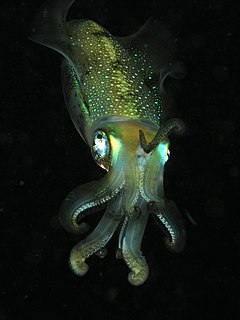
A cephalopod is any member of the molluscan class Cephalopoda such as a squid, octopus, cuttlefish, or nautilus. These exclusively marine animals are characterized by bilateral body symmetry, a prominent head, and a set of arms or tentacles modified from the primitive molluscan foot. Fishermen sometimes call cephalopods "inkfish," referring to their common ability to squirt ink. The study of cephalopods is a branch of malacology known as teuthology.

Subclass Coleoidea, or Dibranchiata, is the grouping of cephalopods containing all the various taxa popularly thought of as "soft-bodied" or "shell-less". Unlike its extant sister group, Nautiloidea, whose members have a rigid outer shell for protection, the coleoids have at most an internal cuttlebone, gladius, or shell that is used for buoyancy or support. Some species have lost their cuttlebone altogether, while in some it has been replaced by a chitinous support structure.

Nautiloids are a large and diverse group of marine cephalopods (Mollusca) belonging to the subclass Nautiloidea that began in the Late Cambrian and are represented today by the living Nautilus and Allonautilus. Nautiloids flourished during the early Paleozoic era, where they constituted the main predatory animals, and developed an extraordinary diversity of shell shapes and forms. Some 2,500 species of fossil nautiloids are known, but only a handful of species survive to the present day.
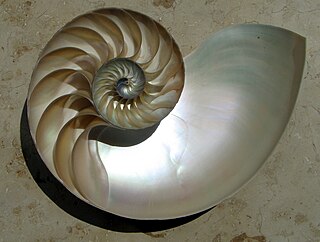
The phragmocone is the chambered portion of the shell of a cephalopod. It is divided by septa into camerae.
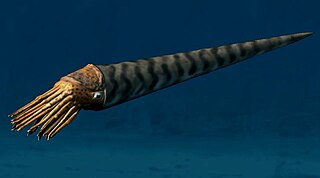
Orthocerida is an order of extinct Orthoceratoid cephalopods also known as the Michelinocerida that lived from the Early Ordovician possibly to the Late Triassic. A fossil found in the Caucasus suggests they may even have survived until the Early Cretaceous. They were most common however from the Ordovician to the Devonian.

Neocephalopods are a group of cephalopod mollusks that include the coleoids and all extinct species that are more closely related to extant coleoids than to the nautilus. In cladistic terms, it is the total group of Coleoidea. In contrast, the palcephalopoda are defined as the sister group to the neocephalopoda.

Knightoconus antarcticus is an extinct species of fossil monoplacophoran from the Cambrian Minaret Formation of Antarctica. It is thought to represent an ancestor to the cephalopods. It had a chambered conical shell, but lacked a siphuncle.

Phragmoteuthis is a genus of extinct coleoid cephalopod known from the late Triassic to the lower Jurassic. Its soft tissue has been preserved; some specimens contain intact ink sacs, and others, gills. It had an internal phragmocone and ten arms.
The Orthocerataceae is a superfamily of orthocerid cephalopods that lived from the late Early Ordovician to the Early Cretaceous, but is no longer in general use.
The Kirengellids are a group of problematic Cambrian fossil shells of marine organisms. The shells bear a number of paired muscle scars on the inner surface of the valve.
The cephalopods have a long geological history, with the first nautiloids found in late Cambrian strata, and purported stem-group representatives present in the earliest Cambrian lagerstätten.
Shimanskya is a late Carboniferous fossil tentatively interpreted as an early spirulid.

Phragmoteuthida is an order of extinct coleoid cephalopods characterized by a fan-like teuthoid pro-ostracum attached to a belemnoid-like phragmocone.
Hematitida is a group of coleoid cephalopods known from the early Carboniferous Period. They are the oldest definite coleoids, although there are controversial claims for even older coleoids from the Devonian. Fossil hematitidans have so far been found only in Arkansas and Utah of the United States. The only family described so far is Hematitidae.
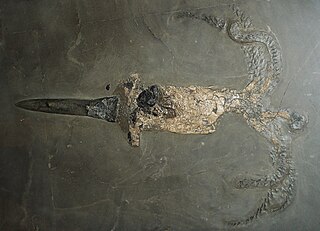
Belemnitida is an extinct order of squid-like cephalopods that existed from the Late Triassic to Late Cretaceous. Unlike squid, belemnites had an internal skeleton that made up the cone. The parts are, from the arms-most to the tip: the tongue-shaped pro-ostracum, the conical phragmocone, and the pointy guard. The calcitic guard is the most common belemnite remain. Belemnites, in life, are thought to have had 10 hooked arms and a pair of fins on the guard. The chitinous hooks were usually no bigger than 5 mm (0.20 in), though a belemnite could have had between 100 and 800 hooks in total, using them to stab and hold onto prey.
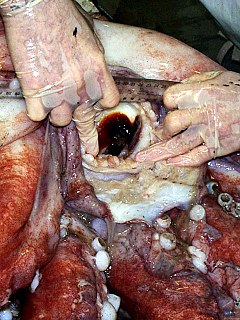
All extant cephalopods have a two-part beak, or rostrum, situated in the buccal mass and surrounded by the muscular head appendages. The dorsal (upper) mandible fits into the ventral (lower) mandible and together they function in a scissor-like fashion. The beak may also be referred to as the mandibles or jaws.
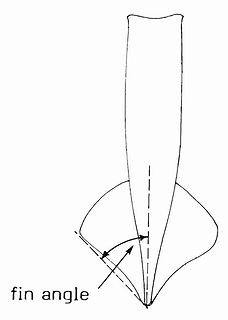
Cephalopod fins, sometimes known as wings, are paired flap-like locomotory appendages. They are found in ten-limbed cephalopods as well as in the eight-limbed cirrate octopuses and vampire squid. Many extinct cephalopod groups also possessed fins. Nautiluses and the more familiar incirrate octopuses lack swimming fins. An extreme development of the cephalopod fin is seen in the bigfin squid of the family Magnapinnidae.
This list, 2017 in paleomalacology, is a list of new taxa of ammonites and other fossil cephalopods, as well as fossil gastropods, bivalves and other molluscs that are scheduled to be described during the year 2017, as well as other significant discoveries and events related to molluscan paleontology that are scheduled to occur in the year 2017.
This list, 2018 in paleomalacology, is a list of new taxa of ammonites and other fossil cephalopods, as well as fossil gastropods, bivalves and other molluscs that are scheduled to be described during the year 2018, as well as other significant discoveries and events related to molluscan paleontology that are scheduled to occur in the year 2018.
This list of fossil molluscs described in 2021 is a list of new taxa of fossil molluscs that were described during the year 2021, as well as other significant discoveries and events related to molluscan paleontology that occurred in 2021.